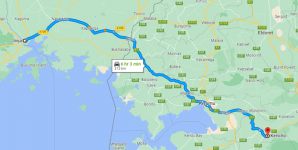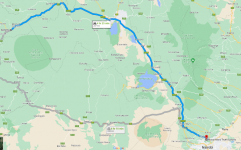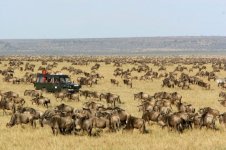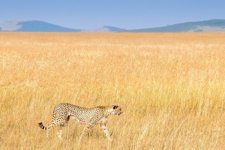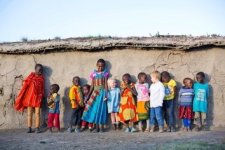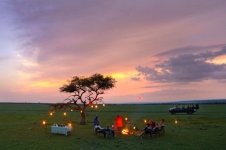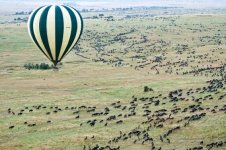September 4 - Day 57 Gorilla Trek (2)
For those of us who completed our gorilla visit, we were provided with options and ideas on how to spend our free day in the area around Kisoro. Some of the options included heading out on more rainforest hikes to see monkeys, take some nature walks, join a hike up Mt Sabinyo – one of five volcanoes located in the Parc National des Volcans – or make a visit to the Batwa community, indigenous to the Great Lakes Region and found throughout Burundi, Rwanda, Uganda and the eastern region of the Congo.
Hugh had set up a hike to Mt. Sabinyo for our family group. Mount Sabinyo is an extinct volcano found within the Virunga range. We learned a ton from the guide that Hugh had hired. Most of it was a geography lesson, but I treated it like one of Grandfather Barry’s lessons on navigation.
Other mountains within the Virunga ranges include Mount
Karisimbi, Muhabura,
Bisoke, Mikeno,
Nyiragongo,
Gahinga and Nyamuragira. Mount Sabinyo is separated from its closest neighbor,
Muhabura, by a crater lake which is 20 meters in diameter. In the local language, Sabinyo means “Old man’s tooth”. This is because its jagged summit looks like worn out teeth when compared to more leveled summits of neighboring mountains.
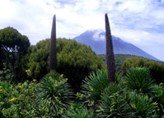
Mount Sabyinyo is 12,037 feet high with a summit that acts as a boundary/border for three countries – Uganda, Rwanda, and the Democratic Republic of Congo. Mount Sabinyo offers one of the most challenging hikes among the Virunga Ranges of mountains. It has rugged slopes and craters on the sides which have created many ridges.
Hiking mount Sabinyo can only be done from Uganda for now because a route has not been created among the sharp ridges on the Congo and Rwanda sides. There are plans by the government of Rwanda to carve a way out through the craters and ridges so that tourists can start the adventure from that side but those plans have been on the books for years and nothing has been done.
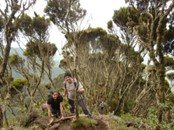
In Uganda, Mount Sabinyo is located in
Mgahinga Gorilla National Park. Despite the sharp ridges and crater lakes before the last peak, the Uganda Wildlife Authority managed to solve some of the problems of reaching the peak by building handmade ladders. They reminded me of some of the Polynesian and Micronesian hikes we took.
Before we started the hike, we registered at the park office, signed the guest book, and finally received our permission to start after receiving our safety briefing. The Guide and Rangers will let us know what to expect, the history of the mountain, and checked our gear (and nodded when they saw my first aid kit and the toilet paper and hygiene wipes in the pocket of my backpack). The guide told us if we didn’t make it to the summit by 3pm, we would need to descend back because it would be too late to complete the activity on time.
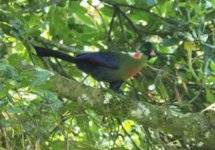
All hikers are given a sturdy walking stick. Hugh said to consider it like gold. The guide asked if Lev needed a porter for his photography equipment but Lev declined. He rarely even lets me carry it and this time he paired down to the most basic. The kids would only be carrying a small emergency pack and their water. I would carry snacks, water, and a bigger emergency equipment pack. Heavy, but using the water as we went would lighten the load. Everyone had at least 2 liters of water of their own and I carried two extra liters for just in case. I also carried a life straw in case we were forced to use a natural water source for drinking water.
We had three locals as part of our trekking group. Apart from the official Guide, an armed ranger is always part of the team to scare away large mammals like elephants that graze on the slopes of the mountain.
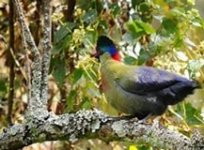
After completing the briefing, we started by passing through a flat area with several swamps. It was after that we started to ascend to an area with thick vegetation zones for the first 2390 to 2800 meters. That area consisted mainly of bamboo and is a favorite habitat of golden monkeys. Apart from the monkeys, our guide told it was possible to encounter mountain gorillas, elephants and buffaloes around the area. We saw the monkeys, heard the elephants, and saw the buffaloes. The guide said we were being watched by a gorilla family group, but we didn’t see any. After the first zone, things changed to a sub-alpine kind of vegetation with fewer trees but home to the rare Rwenzori Turaco. The Rwenzori Turaco is a beautiful bird and a favorite of birders. Some in our group were jealous, but only in a joking way since they’d also seen them. By the time we completed this zone, we could see the summit ahead.
What was cool about climbing the four-hour trek to the summit is that we got to be in three countries (Uganda, Rwanda and Congo) at the same time while having some of the best views you can imagine. The weather was damp when we started, but by the time we got to the summit it was nearly perfect and clear as it rarely was. Hiking Mount Sabinyo involved visiting three peaks. It is at peak three that we stood in three countries at a go. It was also there we had our picnic meal which we were all very much ready for.
In-between the peaks were the extensive ladder system which is where we really developed our hunger. The summit was also very cold, colder than I expected, and I’m glad we had brought layers to wear, including our warmest jacket. Sadie got a little altitude sickness, but we solved that by pushing the fluids. She was cheered to find that there is always at least one person in every hiking party that experiences it, and I told her that until I had a lot more experience in the national parks of the US, I frequently took precautions because of the altitude sickness I endured.
From the summit we could see the Lake Kivu in Rwanda and the Democratic Republic of Congo. We also saw Lake Bunyonyi in Uganda, the Rwenzori ranges of mountains in Uganda, over six mountains of the Virunga region and countless other features that I’m glad Sadie and Benny remember but the names escape me. We could also see patches of human settlements can also amidst green plantations and forests. Congo looked relatively deserted while Rwanda was more densely populated.
Descending was easier, but still challenging in its own way and took just as long as the ascent had. We had to deal with the ladders again and needed to do it carefully. The weather remained clear, but the vegetation was still damp and the trail a little muddy making our hiking boots slightly slippery on occasion.
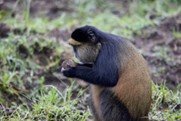
Coming down from the summit we briefly ran into a troop of Golden Monkeys that seemed to have gotten into something they shouldn’t have if their behavior was any indication. Golden monkeys are only found in Uganda, Rwanda and the Democratic Republic of Congo. These “cute” monkeys are endangered and a favorite of tourists and primate lovers. They are extremely playful, with the African eagle and humans their only threat. Well, I was not amused to be treated like a taxi cab by one particularly mischievous adolescent. And he gave one of the female monkeys a minor heart attack by depositing a baby monkey on Sadie’s braids. That was funny … not. Sadie wasn’t upset but the baby didn’t want to turn loose and it took a team effort to get the little fellow untangled and back in his mother’s care. The lead male basically popped the bad-mannered brat to bring him back in line. If he hadn’t, I had been tempted to.
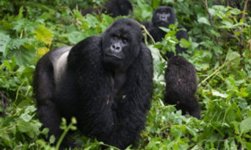
We also had to wait out a family of elephants that were crossing the trail we were using. They were eating and it gave Lev a chance to get some really great photos. And then, right when I thought things couldn’t get any better, we saw them. A silverback came out of the jungle and played crossing guard for the remainder of his family. There were several really young ones and while they weren’t as friendly as the group we met yesterday, they certainly didn’t mind us watching and taking pictures since we were polite and gave them room to do their thing.
We found out at the end of the hike that we got to keep the walking sticks and we also got a special stamp in our passport that we made it to the summit, and it listed all three countries. Benny acted like he had when he’d earned all his Junior Ranger badges. We all said goodbye to the guides and told them how much we appreciated their time. We also left good tips which probably made them happier than the thank yous.
On the way back to camp Hugh had the driver stop at a market and Lev insisted I add a couple of animals to my growing collection. I found a gorilla that was the perfect size and facial expression of the big fellow from yesterday. I also found a Golden Monkey that reminded me of the bratty one from today and I could finally laugh about it. Sadie bought a book on African animals and insisted that it was to share with Benny so they could have some more “characters” for their story. In turn I got a new set of pencils and a sketch book for each of them since they were taking their art seriously. Lev got all of us drinks and Hugh seemed to think he was some kind of Father Christmas the way he was smiling.
Back in camp he was less happy as he was called to a meeting with Klaxton and I worried – not without reason – that someone was going to say something about us taking off on our own despite it being a free day.
After a dinner of Luwombo, a stew steamed in a banana leaf, I caught up with him and asked so I could shut the hamster down.
“Oy, nothing to worry about.”
“Don’t try and blow smoke with that Australian lingo. I’m serious. Is there anything I should know about.”
Hugh snorted. “The man is just trying to say you and the girl need more feminine activities instead of summit hiking.”
“Screw him and the elephant he rode in on. Where does he get off making that decree?”
“Apparently tried to say something to Ol’ Man Wight and didn’t make any headway.”
“Could he make headway?” I asked cautiously.
“Nah. Not with the Ol’ Man thinking he has the situation sewn up to his own liking and convenience. The Lads ain’t fond of Klaxton either from what I’m seeing. They’re respectful of the Ol’ Man’s choices and won’t cut up a fuss, but you just keep your distance. He might be looking into your background. He going to find anything?”
“A hard row to hoe if he screws up things.” At Hugh’s cocked eyebrow I shrugged. “My grandfather was a Captain in the US Navy. My brother died a hero in a place we’re not allowed to know about doing hero-ish things we aren’t allowed to know about either. I was going into the Navy before life happened and I became Benny’s guardian. Lev probably told you the rest. Oh yeah, and I can be a frelling mortal enemy for people that try and screw with my family.”
Hugh nodded, but sighed. “Figured as much. Just don’t let Klaxton try and talk you up if those details make you interesting.”
“Uh no. Even if Lev hadn’t already warned me, I don’t like the vibe Klaxton gives off.”
“Good. Now you might never run down, but I need to get me some beauty sleep. Catch up with Lev and don’t run loose and free.”
Human to jackhole in under five minutes. Dual natured people drive me crazy.
I behaved like a good wifey and caught up. Lev snorted and asked if Hugh had survived.
“By the skin of his teeth,” I smarted off. It made Lev chuckle, but I could tell he was tired and I’ll likely have to give him the full story tomorrow. I’m fine with that. It’ll keep Lev from being able to be used to get a reaction out of me.
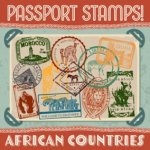
And now I’m trying to wait out my hair to dry before hitting the hay and just realized I haven’t mentioned that we’ve gotten special stamps for our passports in several locations. They’ll be fun to look at when we get back to the River House. I’m going to give the mane another combing to see if that dries it any faster. The hamster is getting anxious to get off the wheel for the night.


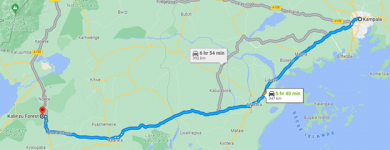

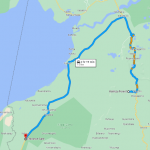
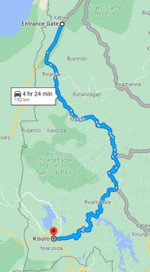
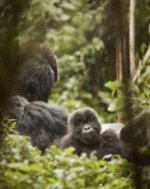







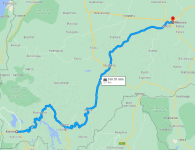
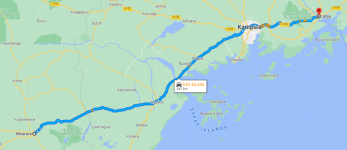
 Thank you very much.
Thank you very much.
